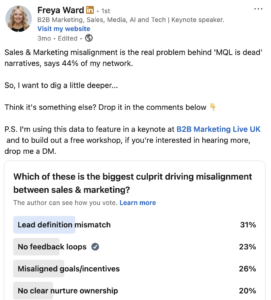How Qualified Outbound (QO) Is Reframing the Conversation Around MQLs
-
October 16, 2025
- 19 min read
-
Quick Summary: The Transition From Marketing Qualified Leads (MQLs) to Qualified Outbound (QO)
The “MQL is dead” narrative may grab clicks, but the reality is that marketing-qualified leads haven’t died, they’ve evolved. Qualified Outbound leads (QOs) are the next step: leads generated by Marketing, nurtured with intent and context, and jointly agreed upon by Sales.
When both teams define and own what “qualified” means, outbound stops being a numbers game and starts being a revenue engine. This guide explores the frustrations felt by both departments and the opportunities for reframing the conversation, and the strategy, for greater alignment between teams.

The Challenge: Different Goals, Same Frustrations
The challenge isn’t that marketing-qualified leads (MQLs) exist. It’s that over time they’ve been either poorly defined, misunderstood or mishandled. We see this all the time:
- Poorly defined leads: Marketing and Sales working to different criteria.
- Misaligned goals: Marketing chases volume, Sales chases deals.
- No feedback loops: leads passed back to marketing with no explanation about why they didn’t progress.
- Tools not fit for purpose: CRMs that aren’t set up to support nurturing or visibility.
The truth is, Sales and Marketing want the same outcome – pipeline and revenue, but they approach it from different angles. That’s where the friction starts.
For Sales teams, it’s simple: they want sales-qualified leads (SQLs) – people who are ready for a sales conversation. Anything less can feel like wasted time, especially if they’ve been burned before by poorly qualified leads passed over from Marketing. Sales teams thrive when they know the outreach will be productive, and they have the information they need before they approach the conversation.
For Marketing, the job is broader: build awareness, generate interest, and nurture potential buyers long before they’re sales ready. That means dealing with nuance: learning what Sales really cares about, balancing campaign goals with business goals, and proving contribution to revenue, not just leads.
Often these differing goals create a disconnect and lead to frustration on both sides. Marketing feels pressured to deliver volume, while Sales only see value in quality.
The result? Misalignment, mistrust and missed opportunities.
Often, the answer isn’t simply “more leads”, it’s more aligned and better qualified leads, defined together. That’s where Qualified Outbound leads come in.
QOs reframe the conversation so both sides are speaking a more sales-friendly language. After all, the direction of travel is from Marketing to Sales, with Sales teams being asked to act, so the information shared needs to resonate with them. When both sides focus on quality over quantity, handovers stop being a battle and start being a catalyst for pipeline growth.

MQL vs SQL vs QO
Let’s be clear on definitions:
- MQL (Marketing Qualified Lead): A lead that meets the ICP and is also showing interest based on engagement metrics as defined by the Marketing team i.e. a content download. MQLs should sit with the Marketing team until they’re ready to be handed over to Sales.
- SQL (Sales Qualified Lead): A lead that Sales people are actively working on, meets the ICP and any other relevant criteria – these could be a result of a cold outbound approach or a lead that has raised their hand through inbound activity (marketing) and asked to be contacted.
- QO (Qualified Outbound Lead): The sweet spot! Before an MQL is ready to be defined as an SQL – these leads need to be treated in the same way as an outbound lead, with no expectation of the lead having raised their hand, however they will be slightly warm. Buy-in from both teams is what makes these leads work.
This middle ground is crucial. QOs aren’t just “marketing’s leads”, they’re jointly owned and tracked, which makes them far more likely to convert.

Shifting From MQLs to Qualified Outbound Leads
Marketers love a good funeral. In fact, scroll your LinkedIn feed and it won’t be long until you find posts declaring tactics “dead”.
At first it was cold calling, then email, now MQLs are in the firing line. But what we’ve learned is that none of these tactics really die – they just mature. Our Global Growth Director, Freya Ward, recently gave a whole talk on this topic (check out her follow up article).
Qualified Outbound leads are a great example. They’re not just a shiny new acronym, they’re a strategic reframing. QOs signal to both Marketing and Sales that the lead fits their ideal customer profile (ICP), has recent and relevant intent, and provides the context needed to progress – while still setting the expectation that they are outbound, to a Sales person, the term outbound means they needs to proactively engage the lead.
This reframing matters. Over time, “MQL” has become shorthand for vanity numbers and shallow qualification. Qualified Outbound leads, on the other hand, are collaborative by design: they’re a signal of alignment, not just a tick on marketing’s scorecard.

`When we think about traditional outbound lead generation, it’s all about being proactive; through paid strategies like content syndication and paid advertising, rather than the longer-term, more organic tactics you’ll use within your inbound lead generation strategy.
Headley Media POV: Outbound should be a shared effort. Marketing builds the audience and pre-qualifies contacts. Sales nurtures and converts. Both do it against a definition of “qualified” they’ve agreed on together.
The Role of Qualification
Qualification is the linchpin of successful lead generation, but it can’t just be a checklist exercise. It needs to be a fluid and ongoing conversation between both departments, based on continual feedback and review.
Too often, qualification is treated as a pass/fail test: Did they download an eBook? Do they fit our ICP? Do they have budget? That reduces people to transactions and leaves Sales second-guessing the value of every handover. This qualification approach often impacts the leads in a negative way, questioning the legitimacy of the data and ultimately challenging marketing’s ability to provide high-quality leads.
True qualification is about context, not just criteria. It’s about providing a richer picture so Sales can step into conversations with confidence and relevance, rather than retracing steps Marketing has already covered.
Qualification isn’t just about ticking boxes. Today, it’s about combining:
- Zero-Party Data – Moving away from unknown third-party data sources and choosing to work with suppliers who can provide zero-party data, generated from their own audiences. Generating leads from zero-party data means you’ll receive better quality and more engaged prospects.
- Behavioral data – Engagement signals such as content downloads, webinar attendance, event participation, and site visits. These reveal what the individual has done and how actively they’re exploring a problem. For example, at Headley Media, our content syndication campaigns provide technology marketers with rich insights into their leads, such as the content they engaged with and additional campaign trends to provide more context to the leads generated.
- Intent data – Third-party research and content consumption trends that highlight what the buyer or account is investigating more broadly. This helps Sales spot whether the lead is part of a wider buying committee or if the topic is rising in importance across the organization.
- Audience intelligence – Such as profiling questions that go beyond demographics: role, challenges, current tech stack, buying stage, and expected timeline. This turns a generic contact into a specific opportunity.
Lead qualification strategies like these enable Marketing to pass over context-rich contacts Sales can action straight away.
On their own, these data points are incomplete. Together, they create a Qualified Outbound profile: someone who fits your ICP, demonstrates real-world intent, and carries enough context for Sales to start a meaningful conversation immediately.
Sales no longer wastes time re-qualifying with shallow openers like “Did you download our whitepaper?”
Instead, they can move directly into value-led discussions such as “I understand you’re exploring X challenge, here’s how we can help...”
This isn’t just operational, it’s psychological. It reframes how Sales perceives Marketing’s leads, shifting them from “numbers to check” into “opportunities to convert.”"
Freya Ward, Global Growth Director, Headley Media
Making Qualified Outbound a Process
Real alignment comes from creating long-term habits, not one-off workshops.
To get this right, Marketing and Sales teams need to:
Define quality together: Run an initial alignment session to agree on what a Qualified Outbound lead looks like. Keep these as a regular session in everyone’s diary – maybe that’s quarterly or every 6-months, whatever works best for you.
Establish a constant feedback loop: Don’t let leads disappear into the void once they’re handed over. Schedule fortnightly lead review huddles where Sales can share structured feedback with Marketing. Keep the format consistent to include:
- Quality checks: Are the leads matching the agreed definition of “qualified”?
- Progress updates: How far are they moving through the pipeline, and where are they stalling?
- Refinement inputs: What adjustments to targeting or criteria could improve conversion?
This rhythm turns feedback into a habit, not an afterthought. Over time, it builds trust, sharpens targeting, and ensures both teams are learning from the same data.
Create shared KPIs: Tie Marketing and Sales goals to pipeline contribution, not just volume.
Nurture deliberately: Assign nurture owners, create persona-based sequences, and recycle leads rather than discarding them.
When this becomes part of the rhythm of how your teams work, QOs get better over time, and trust between Marketing and Sales grows.
A More Strategic Approach to Lead Generation With Headley Media
We’ve seen firsthand how Qualified Outbound transforms results for B2B tech marketers. Here’s what our approach looks like:
- Consent-first data: Every lead is generated transparently through gated content via our seven brands.
- Audience intelligence: We can combine profiling, intent data, and multi-touch journeys to ensure leads are the right fit for our B2B technology clients.
- Enriched delivery: leads include key business card information, such as business-only email address, job role, company details, and engagement history, so outreach can be personalized.
- Alignment built-in: Campaigns are designed to complement your outbound motion, so Sales can work the right accounts at the right time.
The outcome? Better quality leads, lower sales waste, and higher conversion rates.
Final Thoughts
Before we bury MQLs for good, let’s give them the chance to thrive under better conditions. Qualified Outbound isn’t just a rebrand for MQLs, it’s a mindset shift:
- For Marketing, it’s about protecting credibility by delivering leads that Sales understand.
- For Sales, it’s about approaching leads with confidence, knowing they’re vetted but still require proactive outreach.
- And for your C-Suite, it’s about pipeline efficiency and revenue impact, not vanity metrics.
When the mindset shift happens, you stop reporting on “leads thrown over the wall” and start reporting on pipeline created together.
Ready to see what Qualified Outbound looks like in practice? Get in touch to explore how Headley Media can help you generate QOs through content syndication.

